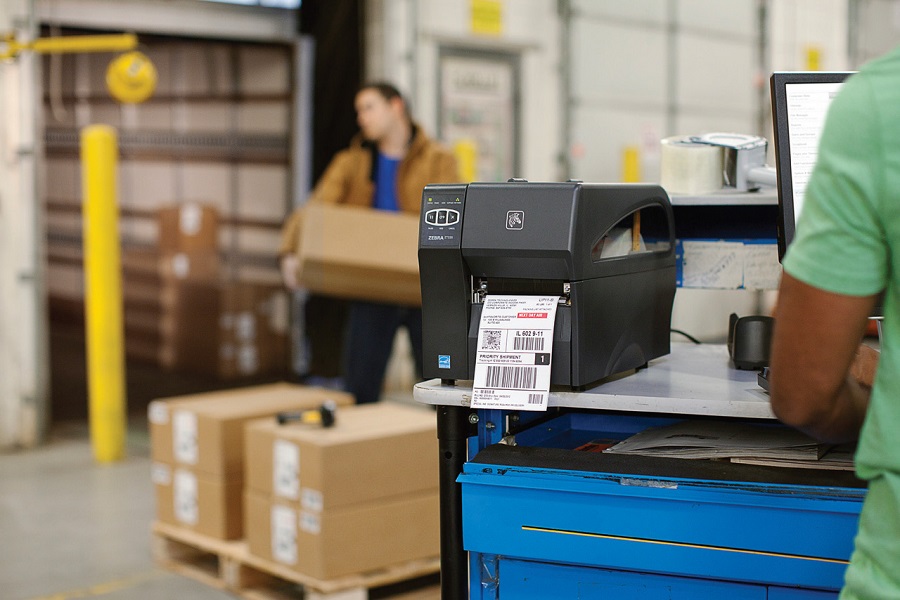For labeling applications, there are two types of industrial printing solutions available: direct thermal and thermal transfer. Determining which type of printing solution to use will depend on your application needs and the environment in which your labels will ultimately have to perform.
The difference between the two approaches lies in the way they create an image. Thermal transfer printing uses a thermal ribbon. The printer’s thermal print head elements heat the backside of the ribbon to melt and transfer the ribbon materials onto the label. These ribbons may be wax, resin, or a combination of the two.
With direct thermal printing, the label itself is heat sensitive. The print head elements directly contact the label material, which causes a color change and the creation of the image on the label.
When you are making a choice between the two types of printers, it’s helpful to look at some of the advantages and disadvantages of each:
Printhead Life: Because direct thermal printheads come in direct contact with labels, the printheads tend to have a shorter lifecycle than thermal transfer printing solutions. That’s because the thermal ribbon provides protection to the printhead, resulting in less wear. Dust and debris on labels can also damage the printhead in direct thermal applications. Because of this, direct thermal printheads may only offer 25% to 50% of the life of a thermal transfer printhead.
Cost: While direct thermal printers don’t require a ribbon, the labels themselves are often more expensive than thermal transfer labels — enough to eliminate any potential savings in ribbon expenses, depending on the size and media type.
Complexity: Direct thermal-only printers usually have fewer moving parts, are less complex, and easier to service. Thermal transfer printers require adjustment and setting of thermal ribbons, as well as replacement of the ribbon (which can result in downtime for the label operation or production line.)
Label Durability: Operating environments will determine just how durable the labels need to be, and what conditions they need to withstand. If the labels need to last for an extended period of time, or are exposed to sunlight, chemicals, or other harsh conditions, thermal transfer printing provides better performance.
For example, a metalworking company used ARMOR’s AXR7+ ribbon for labeling metal parts that are covered by a thermo-retracted plastic film. The heat used in the packaging process could transfer ink on the film, which compromises legibility. The resin ink used in this application is heat resistant enough to avoid compromising the label. ARMOR also offers a range of premium wax/resin and resin ribbons (such as APR 6, APX FH+ and AXR 8) that can be used in hot food packaging, frozen food packaging, and for outdoor applications.
Direct thermal labels, which are more sensitive to heat, light, and abrasion, are often used in short lifecycle applications, such as labeling meat and dairy products. This type of label is also sometimes used on patient wristbands and pharmaceutical prescriptions because of its short lifespan, which helps ensure patient privacy.
Flexibility: Thermal transfer printing solutions can accept a wider variety of label media materials (and sizes) than direct thermal printers, which makes them a good fit for a wider variety of applications.
Barcode Quality: Because thermal transfer labels provide a more durable image, they are preferable for bar-code labeling applications that require high-quality, accurate images with good edge definition. Because direct thermal labels can smear, they can’t meet these requirements.
So while direct thermal printers are less expensive and don’t require ink or ribbon, they do present several important disadvantages when it comes to mission-critical barcode and other labeling applications. They are susceptible to environmental damage and are prone to fading; the printheads may wear out faster; they can’t print small text or high quality images and barcodes; and they can only print black on white.
Thermal transfer printing technology provides higher quality labels that last much longer, and can be deployed with a variety of label stocks.
Before investing in a labeling solution, carefully evaluate your application needs and select the most cost-effective printer for your business.




